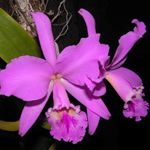
 |
 |
|
Most Common Orchids
Other Links
|
| Home | | | Anguloa | | | Cattleya | | | Cymbidium | | | Oncidium | | | Epidendrum | | | Catasetum | | | Miltonia | | |
|
Cattleya
Cattleya orchids are found in Mexico to Brazil. It is roughly divided into labiate and bifoliate. Both groups contain narrow Pseudobulbs and leathery leaves. Many beautiful hybrids have been produced from Cattleya species. Flowers usually appear from the top of the pseudobulb. The cut flowers last one to two weeks. The plant needs warm temperature, bright but not burning light, good air circulation high humidity and excellent drainage. It needs less water when it is not actively growing.
Light : Cattleyas need bright light. Flowering depends upon the amount of sunlight. It will not flower without plenty of light. Darker leaves indicate too little light whereas yellow or brown might indicate too much direct sunlight.
Water : We must water heavily during growing season, but don't allow them to sit in water. We can stop water when flowers begin to emerge from their sheaths.
Fertilizer : Fertilize with weak orchid fertilizer weekly during growing season. Fertilize every other week during rest period.
Blooming : Usually Cattleya produce one new flush of growth annually each new pseudo bulb should produce flowers at same growing season, often in late summer or winter. Some hybrid might produce two blooms annually. When plant goes into flower, reduce watering to avoid accidentally rotting the flowers.
Potting & Repotting : Cattleyas grow by means of branching, creeping rhizome with thick, clinging root. Repotting is stressful, plant take a season to recover. They grow well in most orchid mixes including pink bark, clay pellets perlite, charcoal or any well draining medium. During repotting, there must be enough space for rhizome to produce at least two new pseudo bulbs before it hits the edge of pot. Repotting is done in spring, at beginning of growing season.
Grower's Tips : Depending upon the species, they may produce just few showy flowers or bunches of smaller, waxy flowers. The big mistake most people make with Cattleya is not supplying enough light for plant to bloom well or overwatering. A plump lead pseudobulb indicates a well-hydrated plant.
